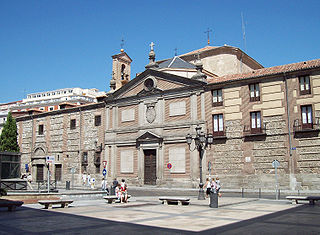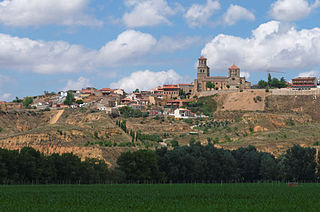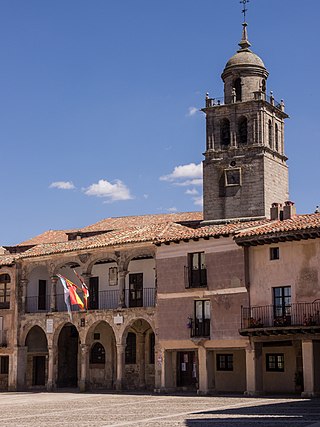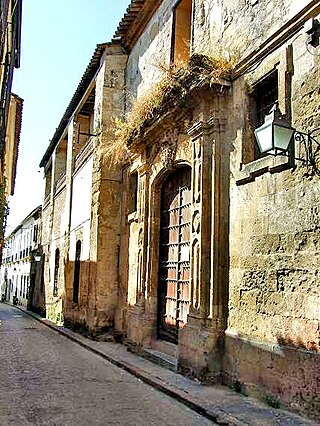Related Research Articles

The Convent of Christ is a former Catholic convent in Tomar, Portugal. Originally a 12th-century Templar stronghold, when the order was dissolved in the 14th century the Portuguese branch was turned into the Knights of the Order of Christ, that later supported Portugal's maritime discoveries of the 15th century. The convent and castle complex are a historic and cultural monument and was listed as a UNESCO World Heritage site in 1983.
Magdalena de la Cruz (1487–1560) was a Franciscan nun of Córdoba in Spain, who for many years was honored as a living saint. However, St. Ignatius Loyola had always regarded her with suspicion. Falling dangerously ill in 1543, Magdalena confessed that her stigmata and claims of performing miracles were fraudulent. She was sentenced by the Inquisition, in an auto-da-fé at Córdoba in 1546, to perpetual imprisonment in a convent of her order, and there she is believed to have ended her days most piously amid marks of the sincerest repentance.

The Convent of Las Descalzas Reales is a royal monastery situated in Madrid, Spain, administered by the Patrimonio Nacional.

Toro is a town and municipality in the province of Zamora, part of the autonomous community of Castile and León, Spain. It is located on a fertile high plain, northwest of Madrid at an elevation of 740 metres (2,430 ft).

Santa Isabel Island is the longest in Solomon Islands, the third largest in terms of surface area, and the largest in the group of islands in Isabel Province.
São Vicente is a former freguesia, located in the municipality of Abrantes, in Santarém District, Portugal. In 2013, the parish merged into the new parish Abrantes e Alferrarede. The population in 2011 was 11,622, in an area of 38.20 km². It included the northern part of the city of Abrantes.

The Santa Isabel College, also referred to by its acronym SIC, is a private, Roman Catholic college owned and operated by the Sisters of Charity of Saint Vincent De Paul in Ermita, Manila, Philippines. It was founded on 24 October 1632. Santa Isabel College is one of the oldest colleges in the Philippines and in Asia.

Daroca is a city and municipality in the province of Zaragoza, Aragon, Spain, situated to the south of the city of Zaragoza. It is the center of a judicial district.

Medinaceli is a municipality and town in the province of Soria, in Castile and León, Spain. The municipality includes other villages like Torralba del Moral.

Llerena is a municipality located in the province of Badajoz, Extremadura, Spain. According to the 2007 census (INE), the municipality has a population of 5,995 inhabitants. Llerena, a town that declared itself a Historical Artistic gathering on December 29, 1966, is located in southwestern Spain. The head of the judicial and economic center of the region of the country of the same name, it is equidistant from 20 municipalities, and sits at the confluence of the District 432 and 413 National Roads.

Valdunquillo is a municipality located in the province of Valladolid, Castile and León, Spain. According to the 2004 census (INE), the municipality has a population of 179 inhabitants. The town's residents traditionally call themselves "lechugeros," a testament to the fact that the town had a good reputation for cultivating lettuce. Valdunquillo is adjacent to the towns La Unión de Campos, Villalogán, Bolaños de Campos, Valderas, Medina de Rioseco, and Villavicencio de los Caballeros.

The Real Monasterio de la Encarnación is a convent of the order of Recollet Augustines located in Madrid, Spain. The institution mainly interned women from noble families, and was founded by the Queen Margaret of Austria, wife of Philip III, and thus was well endowed with wealth. Although it belongs to an enclosed religious order, the building is open to the public under the administration of the Patrimonio Nacional.
Juan Gómez de Mora (1586–1648) was a Spanish architect, active in the 17th century. He was a main figure of Spanish early-Baroque architecture in the city of Madrid. Spanish art historian Virginia Tovar Martín has published scholarly works on Gómez de Mora.

Convento de Santa Clara is a defunct convent located on Calle del Rey Heredia in Córdoba, Andalusia, Spain. Situated in the historic centre, it was the first convent in the city after the Reconquista of October 1265. It was built atop a Muslim mosque dating to 976 which, in turn, had been built on the Basilica of Santa Catalina, in the 6th century. The minaret, re-fashioned into a bell-tower, and the building's Calle Osio portal date to this period. The convent was initially situated within the mosque and had eight nuns. Throughout its history, it went by various names. Originally known Santa Catalina, it became "Santa Clara" after installation of the Poor Clares; it was also known as "Santa Isabel" during a time of tribute to Isabella of France who had strong ties to the Spanish Crown. The religious order was incorporated to Santa Cruz in 1868, when the convent was abandoned. The minaret/bell tower was declared a Bien de Interés Cultural site in 1931. Muslim towers, battlements, and a staircase have been retained.

The Walls of Madrid are the five successive sets of walls that surrounded the city of Madrid from the Middle Ages until the end of the 19th century. Some of the walls had a defensive or military function, while others made it easy to tax goods entering the city. Towards the end of the 19th century the demographic explosion that came with the Industrial Revolution prompted urban expansion throughout Spain. Older walls were torn down to enable the expansion of the city under the grid plan of Carlos María de Castro.
The Walls del Arrabal were the third in a set of five walls built around Madrid, now the capital of Spain. There are no remaining ruins of the Walls del Arrabal, leaving some debate as to their extent and the period of their construction. It is possible that the walls were built as early as the 12th century, however they were most likely constructed in 1438. The walls may have been intended to protect people against the plagues that ravaged the city at the time. The walls united the urbanized suburbs of the city and prevented entry of the infected.

The Convento de Santa Isabel de los Reyes is a convent located in the city of Toledo, in Castile-La Mancha, Spain. The current convent, founded in 1477 by Doña María Suárez de Toledo, known as "Sor María la Pobre", has its origins in two different palaces, both Mudéjar from the 14th century and the church of San Antolín.

The Royal Convent of Jesús María and Our Lady of Mercy is a church in the historic center of Mexico City, Mexico. Originally a convent for orphaned and undowried girls, Jesús María was the third Conceptionist convent in Mexico City when it was formed in 1580. Its founders were granted financial support from Philip II of Spain, who planned to make Jesús María a leading convent in New Spain.

The Convent of St. Clare is a former cloistered convent of the Order of Poor Clares, located in the city centre of Pontevedra, Spain, precisely in Santa Clara Street, near the disappeared St. Clare Gate of the medieval city walls. Founded in 1271, the convent closed in 2017. In 2021 the City Council bought the building from the Order, and in 2023 it transferred it to the Provincial Deputation to become part of the Pontevedra Museum.
References
- ↑ Conrad Kent; Thomas Wolber; Cameron M. K. Hewitt (2000). The lion and the eagle: interdisciplinary essays on German-Spanish relations over the centuries. Berghahn Books. pp. 83, 106. ISBN 1-57181-131-1.
